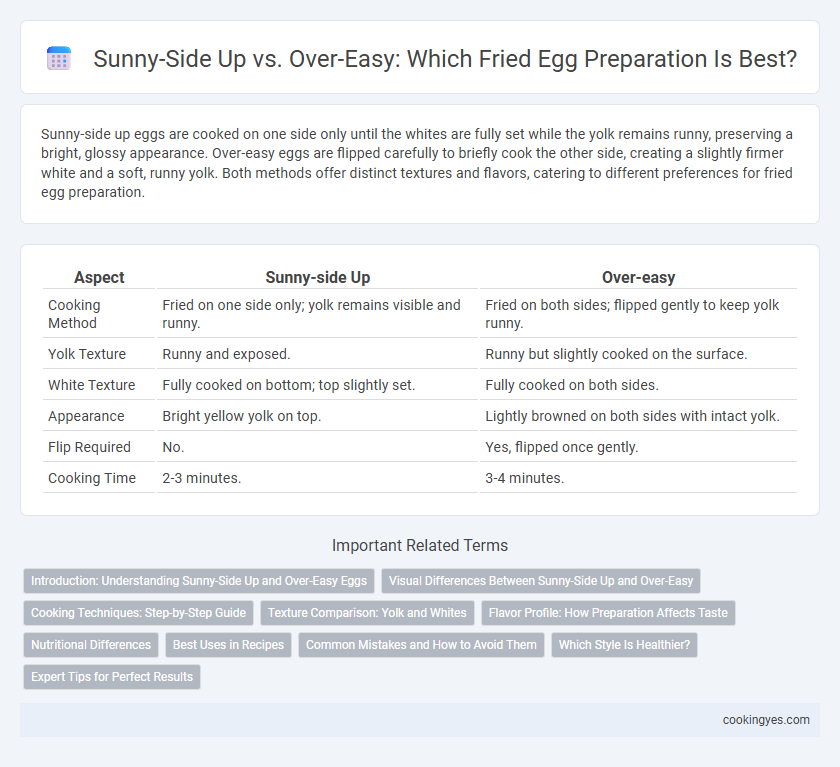Sunny-side up eggs are cooked on one side only until the whites are fully set while the yolk remains runny, preserving a bright, glossy appearance. Over-easy eggs are flipped carefully to briefly cook the other side, creating a slightly firmer white and a soft, runny yolk. Both methods offer distinct textures and flavors, catering to different preferences for fried egg preparation.
Table of Comparison
| Aspect | Sunny-side Up | Over-easy |
|---|---|---|
| Cooking Method | Fried on one side only; yolk remains visible and runny. | Fried on both sides; flipped gently to keep yolk runny. |
| Yolk Texture | Runny and exposed. | Runny but slightly cooked on the surface. |
| White Texture | Fully cooked on bottom; top slightly set. | Fully cooked on both sides. |
| Appearance | Bright yellow yolk on top. | Lightly browned on both sides with intact yolk. |
| Flip Required | No. | Yes, flipped once gently. |
| Cooking Time | 2-3 minutes. | 3-4 minutes. |
Introduction: Understanding Sunny-Side Up and Over-Easy Eggs
Sunny-side up eggs are cooked on one side until the whites are fully set while the yolks remain runny and exposed, offering a bright, intact appearance. Over-easy eggs involve gently flipping the egg to briefly cook the yolk's surface while maintaining a soft, slightly runny center. Both methods highlight different textures and cooking styles essential for versatile fried egg preparation techniques.
Visual Differences Between Sunny-Side Up and Over-Easy
Sunny-side up eggs have a fully visible, bright yellow yolk on top with whites cooked until just set, resulting in a glossy, unflipped appearance. Over-easy eggs feature a lightly cooked yolk partially covered by whites due to a brief flip during cooking, creating a tender, slightly browned surface on both sides. The visual contrast lies in the intact, exposed yolk of sunny-side up eggs versus the subtly seared, evenly cooked exterior of over-easy eggs.
Cooking Techniques: Step-by-Step Guide
Sunny-side up eggs are cooked on one side only, with the yolk remaining runny and the whites fully set by gently frying on medium-low heat without flipping. Over-easy eggs require cooking on one side until the whites are mostly set, then carefully flipping to briefly cook the other side, preserving a runny yolk. Using a non-stick pan and controlled heat is essential for both techniques to prevent breaking the yolk and achieve the desired texture.
Texture Comparison: Yolk and Whites
Sunny-side up eggs feature a fully runny yolk with whites that are set but tender, offering a smooth texture contrast between creamy yolk and slightly firm whites. Over-easy eggs have a lightly flipped cooking method, resulting in a slightly firmer yolk that maintains a soft, custard-like consistency while the whites become uniformly cooked with a tender, not rubbery, texture. The yolk texture in sunny-side up remains bolder and more liquid, whereas over-easy balances softness with slight firmness for a more cohesive bite.
Flavor Profile: How Preparation Affects Taste
Sunny-side up eggs have a rich, creamy yolk with a slightly custard-like texture, offering a delicate, buttery flavor due to minimal cooking on the yolk. Over-easy eggs develop a more uniform texture and a mild, slightly savory taste as the brief flip allows the yolk to firm slightly while retaining moisture. The gentle cooking differences influence the balance between creaminess and firmness, significantly affecting the overall flavor and mouthfeel of fried eggs.
Nutritional Differences
Sunny-side up eggs retain more vitamins such as B12 and folate due to minimal cooking, preserving heat-sensitive nutrients. Over-easy eggs experience slight nutrient loss with brief flipping, causing some reduction in antioxidants and water-soluble vitamins. Both methods provide high-quality protein and essential amino acids, but sunny-side up maximizes vitamin retention.
Best Uses in Recipes
Sunny-side up eggs maintain a bright, runny yolk ideal for dishes like avocado toast or breakfast sandwiches where visual appeal and yolk texture are key. Over-easy eggs involve flipping the egg briefly, producing a slightly cooked yolk perfect for recipes requiring gentle yolk set, such as eggs benedict or hash browns. Choosing between sunny-side up and over-easy depends on desired yolk consistency and how the egg complements the overall dish texture.
Common Mistakes and How to Avoid Them
Sunny-side up eggs often suffer from undercooked whites and overcooked edges, a mistake corrected by cooking on low heat and covering the pan briefly to steam the top. Over-easy eggs commonly fall apart when flipped too early or with excessive force, so using a non-stick pan and a thin, flexible spatula ensures gentle handling. Avoiding high heat prevents rubbery whites and runny yolks, maintaining the ideal texture for both sunny-side up and over-easy fried eggs.
Which Style Is Healthier?
Sunny-side up eggs retain more nutrients because the yolk remains intact and less cooked, preserving vitamins like B12 and antioxidants. Over-easy eggs are flipped and lightly cooked on both sides, which slightly reduces some heat-sensitive nutrients but allows for safer consumption by reducing raw surface bacteria. Overall, sunny-side up eggs offer higher nutrient retention, while over-easy eggs may present a lower risk of foodborne illness.
Expert Tips for Perfect Results
For perfect fried eggs, cook sunny-side up by frying on low heat until white sets but yolk remains runny, avoiding flipping to preserve yolk integrity. Over-easy eggs require a gentle flip after whites firm, cooking briefly on the second side to achieve a slightly cooked yolk with runny center. Use a non-stick pan, fresh eggs, and controlled heat for optimal texture and flavor in both methods.
Sunny-side up vs Over-easy for Fried Egg Preparation Infographic

 cookingyes.com
cookingyes.com